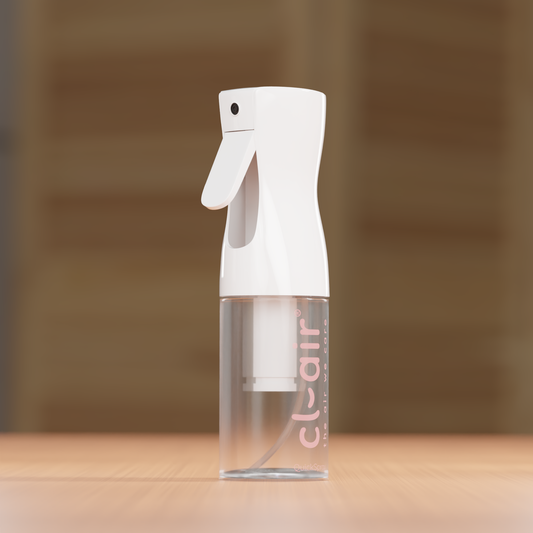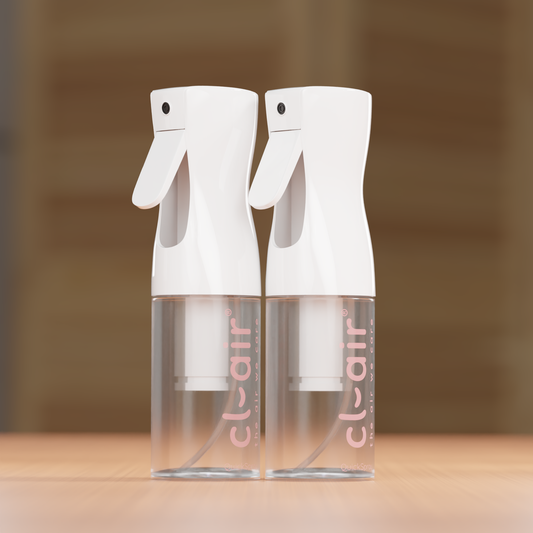Formaldehyde is a colourless and strong-smelling chemical, commonly used in various household products and building materials.
There are 3 main types of formaldehyde in a household:
| Types of formaldehyde | Solution |
| Free Formaldehyde: Formaldehyde present in indoor air due to off-gassing from furniture, paints, and adhesives. | Ensure good ventilation and, if possible, expose the space to direct sunlight. Using a certified air purifier for formaldehyde removal can further accelerate dissipation. |
|
Formaldehyde on Surfaces: Residual formaldehyde that accumulates over time, usually settling on wood and walls. |
Clean with cl-air QuickSpray to neutralise and remove formaldehyde buildup. Tested and proven to remove up to 92.2% Formaldehyde on wood surfaces for immediate action. |
|
Releasable Formaldehyde: Formaldehyde that is gradually released from wood, adhesives, and synthetic materials over time. |
Use cl-air AirShield, a potassium-based formula that neutralises and seals releasable formaldehyde, preventing off-gassing for long-term protection. |
Common Source of Formaldehyde?

Formaldehyde is commonly found in building materials, household products, and personal care items such as pressed wood, carpets, cosmetics, and cleaning supplies. It is also present in tobacco smoke, fuel-burning appliances, and certain textiles. The release of formaldehyde from these sources contributes to indoor air pollution, emphasising the importance of ventilation and choosing low-emission products to minimise exposure.
How can Formaldehyde be harmful?
Formaldehyde exposure poses multiple health risks, particularly during pregnancy, where it has been associated with a slightly increased risk of certain birth defects and miscarriage. Inhaling formaldehyde vapors can lead to respiratory irritation, causing symptoms like coughing, wheezing, and nasal discomfort, potentially affecting sleep quality.1

Formaldehyde exposure may worsen asthma symptoms and trigger asthma attacks in susceptible individuals. It can also cause eye and skin irritation, allergic reactions, headaches, dizziness, and general discomfort. Of significant concern is the potential for an elevated risk of cancer, with long-term and high-level formaldehyde exposure associated with specific types of cancer. Studies suggest a possible link between prolonged formaldehyde exposure and cognitive impairments, as well as potential effects on the immune system, liver, and kidneys.2
Will Formaldehyde go away by itself?
While Formaldehyde can dissipate over time, achieving complete removal in a household may be challenging, especially if the source persists. To enhance the reduction of formaldehyde concentrations, air purifiers equipped with specific technologies, such as activated carbon filters or formaldehyde-removal catalysts, prove more effective. These technologies actively target and absorb formaldehyde molecules, providing a proactive approach to improving indoor air quality by addressing the issue at its source.
Can Pineapple/Coffee Beans or Plants Really Remove Formaldehyde?

Pineapples and coffee beans are not scientifically proven to have Formaldehyde removal properties. While certain plants may aid in air purification, their effectiveness in removing Formaldehyde is limited, requiring an impractical number of plants for extended periods. For addressing formaldehyde concerns, relying on established methods such as ventilation, air purifiers with specific technologies, and formaldehyde-removal catalysts is more effective.
Source:
1 https://www.atsdr.cdc.gov/formaldehyde/
2 https://www.cancer.gov/about-cancer/causes-prevention/risk/substances/formaldehyde/formaldehyde-fact-sheet





